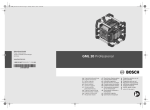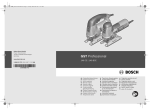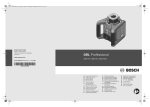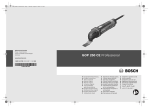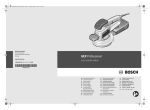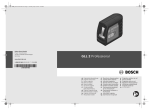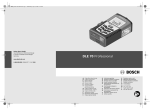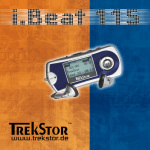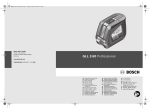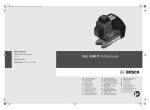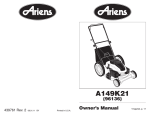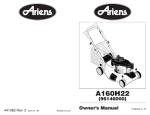Download Bosch GML 20 Professional Technical data
Transcript
OBJ_BUCH-1267-001.book Page 1 Monday, July 26, 2010 12:02 PM UT M CE UR SO E Vo Ba lum ss e Treb Eq M Po we rB ox ua liz em or er y Cus to m Clo ck + Tu ne – – Se ek Se ek So + ur ce BB AA Robert Bosch GmbH Power Tools Division 70745 Leinfelden-Echterdingen Germany GML 50 Professional www.bosch-pt.com 1 609 929 W38 (2010.07) T / 396 UNI de en fr es pt it nl Originalbetriebsanleitung Original instructions Notice originale Manual original Manual original Istruzioni originali Oorspronkelijke gebruiksaanwijzing da Original brugsanvisning sv Bruksanvisning i original no Original driftsinstruks fi Alkuperäiset ohjeet el tr pl cs sk hu ru Πρωτότυπο οδηγιών χρήσης Orijinal işletme talimat Instrukcja oryginalna Původní návod k používání Pôvodný návod na použitie Eredeti használati utasítás Оригинальное руководство по эксплуатации uk Оригінальна інструкція з експлуатації ro Instrucţiuni originale bg Оригинална инструкция sr sl hr et lv lt Originalno uputstvo za rad Izvirna navodila Originalne upute za rad Algupärane kasutusjuhend Instrukcijas oriģinālvalodā Originali instrukcija ar ΔϴϠλϷ ϞϴϐθΘϟ ΕΎϤϴϠόΗ fa ̶Ϡλ έΎ̯ ίήσ ̵ΎϤϨϫέ OBJ_BUCH-1267-001.book Page 3 Monday, July 26, 2010 12:03 PM 3| a b c d e f g h i j k o n m l 1 E UT M CE UR SO 2 3 1 1 Vo Bas lum s Tr e eb Eq M Po we rB ua liz em 1 ox er ory Cus to m Clo ck 4 + Tu ne –S – ee k See k+ 5 A So ur ce BB 7 8 6 9 SOURCE MUTE 10 11 12 13 14 15 GML 50 Professional 16 1 609 929 W38 | (26.7.10) Bosch Power Tools OBJ_BUCH-1267-001.book Page 4 Monday, July 26, 2010 12:03 PM 4| A 18 M UT E 17 SO UR CE REPLACE AA BATTERY WHEN UNIT NO LONGER KEEPS CORRECT TIME. E LINT OU V 12 X AU IN 1 B ia ed lM ita Dig ay 25 24 23 22 21 B 20 19 26 27 28 29 39 PowerBox 38 + 37 Volume Bass Treb Equalizer Memory Custom Tune Clock – 30 31 36 35 32 – Seek Seek + Source 1 609 929 W38 | (26.7.10) 33 34 Bosch Power Tools OBJ_BUCH-1267-001.book Page 5 Monday, July 26, 2010 12:03 PM 5| C 40 41 42 AUX 1 IN N SD / MMC 48 43 44 LINE L LIN LI IN OUT 250V 1AMP FUSE FOR 12V OUTLET USB AUX 2 IN 47 46 43 45 14,4 V (Li-Ion) 2 607 336 150 (1,3 Ah) 2 607 336 078 (2,6 Ah) 2 607 336 224 (3,0 Ah) 1 609 929 W38 | (26.7.10) 18 V (Li-Ion) 2 607 336 170 (1,3 Ah) 2 607 336 092 (2,6 Ah) 2 607 336 236 (3,0 Ah) Bosch Power Tools OBJ_BUCH-1267-001.book Page 20 Monday, July 26, 2010 12:03 PM 20 | English Safety Notes en WARNING Read all safety warnings and all instructions, including the information on the bottom side of the radio charger. Failure to follow the warnings and instructions may result in electric shock, fire and/or serious injury. Save all safety warnings and instructions for future reference. f Take care that the mains plug can be pulled at any time. The mains plug is the only possibility to disconnect the radio charger from the mains supply. f Protect the radio charger from rain and moisture. The penetration of water into the radio charger increases the risk of an electric shock. The term “radio charger” used in the safety notes, refers to mains-powered radio chargers (with mains cable) and to battery-operated radio chargers (without mains cable). f Do not charge the batteries of other manufacturers. The battery charger is suitable only for charging Bosch lithium ion batteries with the voltages listed in the technical data. Otherwise there is danger of fire and explosion. f Keep work area clean and well lit. Cluttered or dark areas invite accidents. f Keep the radio charger clean. Contamination may result in danger of electric shock. f The plug of the radio charger must match the outlet. Never modify the plug in any way. Do not use any adapter plugs with earthed (grounded) radio chargers. Unmodified plugs and matching outlets will reduce the risk of electric shock. f Check the radio charger, cord and plug each time before using. Do not use the radio charger when defects are detected. Do not open the radio charger yourself and have it repaired only by qualified personnel using original spare parts. Damaged radio chargers, cords and plugs increase the risk of electric shock. f Do not misuse the cord to carry the radio charger, hang it up, or for pulling the plug out of the outlet. Keep the cord away from heat, oil, sharp edges or moving parts. Damaged or entangled cords increase the risk of electric shock. f When operating the radio charger outdoors, only use extension cords suitable for outdoor use. Use of a cord suitable for outdoor use reduces the risk of electric shock. f When operating the radio charger in damp environments is unavoidable, use a residual current device (RCD). The use of a residual current device (RCD) reduces the risk of electric shock. f Do not operate the radio charger on easily inflammable surfaces (e.g. paper, textiles, etc.) or in inflammable environments. Fire hazard due to occurring heat build-up of the radio charger during charging. f In case of damage and improper use of the battery, vapours may be emitted. Provide for fresh air and seek medical help in case of complaints. The vapours can irritate the respiratory system. f Children should be supervised to ensure that they do not play with the radio charger. f Connect the radio charger to a mains supply that is properly connected to earth. Socket and extension cord must have an operative protective conductor. f Children or persons with mental or physical limitations may only use the radio charger under supervision or after having been instructed. A thorough introduction reduces operating errors and injuries. f Completely unwind the mains cable when operating the radio charger via mains supply. Otherwise the mains cable can heat up. f Do not open the battery. Danger of shortcircuiting. 1 609 929 W38 | (26.7.10) Protect the battery against heat, e.g., against continuous intense sunlight, fire, water, and moisture. Danger of explosion. Bosch Power Tools OBJ_BUCH-1267-001.book Page 21 Monday, July 26, 2010 12:03 PM English | 21 f When battery pack is not in use, keep it away from other metal objects like paper clips, coins, keys, nails, screws, or other small metal objects that can make a connection from one terminal to another. Shorting the battery terminals together may cause burns or a fire. Functional Description f Under abusive conditions, liquid may be ejected from the battery; avoid contact. If contact accidentally occurs, flush with water. If liquid contacts eyes, additionally seek medical help. Liquid ejected from the battery may cause irritations or burns. Use the radio charger only when you fully understand and can perform all functions without limitation, or have received appropriate instructions. f Recharge only with the charger specified by the manufacturer. A charger that is suitable for one type of battery pack may create a risk of fire when used with another battery pack. The numbering of the product features refers to the illustration of the radio charger on the graphics page. f Only use the battery in conjunction with your radio charger and/or a Bosch power tool. This is the only way to protect the battery against dangerous overload. f Use only original Bosch Professional 14.4 V and 18 V lithium ion batteries. When using other batteries, e.g. imitations, reconditioned batteries or other brands, there is danger of injury as well as property damage through exploding batteries. f Read and strictly observe the safety warnings and working instructions in the operating instructions of the tools that you connect to the radio charger. f Products sold in GB only: Your product is fitted with an BS 1363/A approved electric plug with internal fuse (ASTA approved to BS 1362). If the plug is not suitable for your socket outlets, it should be cut off and an appropriate plug fitted in its place by an authorised customer service agent. The replacement plug should have the same fuse rating as the original plug. The severed plug must be disposed of to avoid a possible shock hazard and should never be inserted into a mains socket elsewhere. Bosch Power Tools Read all safety warnings and all instructions. Failure to follow the warnings and instructions may result in electric shock, fire and/or serious injury. Product Features 1 Speaker 2 Remote control 3 Carrying handle 4 Control lamp for A/C supply (not for article number 3 601 D29 660) 5 A/C outlet cover (not for article number 3 601 D29 660) 6 A/C socket outlet (not for article number 3 601 D29 660) 7 “|<<” button on the remote control 8 Outlet opening for infra-red beam 9 Increase volume button 10 “>>|” button on the remote control 11 Play/pause button on the remote control 12 Reduce volume button 13 On/Off button for audio operation on the remote control 14 “Source” button for audio source on the remote control 15 “Mute” button 16 Loop-clip button 17 Latch of back-up battery lid 18 Back-up battery lid 19 Locking latch of digital media bay flap 20 Digital media bay flap 1 609 929 W38 | (26.7.10) OBJ_BUCH-1267-001.book Page 22 Monday, July 26, 2010 12:03 PM 22 | English 21 Rod antenna Display elements for audio operation 22 Charging compartment a Equalizer (sound-pre-set) indicator 23 Locking latch of battery lid b Changing treble – indicator 24 Battery lid c Changing bass – indicator 25 Battery* d Indicator for volume, memory location for radio station and title (depends on the selected audio source) 26 “Equalizer” button 27 “Memory ” button 28 “Custom” button (for manual sound adjustment) 29 “Clock” button (for setting the time) 30 “Tune” adjustment knob (for tuning of stations) 31 Reception lens for remote control 32 Button for random playback/repeat 33 “Seek +/>>|” button 34 “Source” button (for selecting an Audio Source) 35 “|<</– Seek” button 36 Play/pause button 37 Adjustment knob for volume level (“Volume”) and sound (“Bass/Treb”) 38 On/Off button for audio operation 39 Display 40 “AUX 1 IN” socket 41 12 V connection socket e Station-memory reception indicator (for radio operation) f Random playback indicator (for SD/MMC card or USB audio source) g Repeat-current-track indicator for all tracks in the current folder/directory (for SD/MMC card or USB audio source) h Repeat-current-track indicator (for SD/MMC card or USB audio source) i Stereo indicator j Indicator of radio frequency/Play duration of current track (depends on the selected audio source) k Temperature warning l Battery inserted indicator m Battery charge indicator n Audio-source indicator o Time indication display 42 “LINE OUT” socket 43 Fuse cap 44 Fuse for 12 V connection 45 USB port 46 SD/MMC slot 47 “AUX 2 IN” socket 48 Holder for external audio sources *Accessories shown or described are not part of the standard delivery scope of the product. A complete overview of accessories can be found in our accessories program. 1 609 929 W38 | (26.7.10) Bosch Power Tools OBJ_BUCH-1267-001.book Page 23 Monday, July 26, 2010 12:03 PM English | 23 Technical Data Radio Charger GML 50 Professional 3 601 D29 6.. Article number 2 x 1.5 V (LR06/AA) Back-up batteries Operating temperature °C 0...45 Storage temperature °C –20...+70 Weight according to EPTA-Procedure 01/2003 kg 11.2 /I Protection class IP 54 (dust and splash water protected) Degree of protection Audio Operation/Radio Operating voltage – for mains operation – for battery operation Rated output of amplifier (for mains operation) Reception angle of remote control Reception range – FM – AM V V 230/110 14.4–18 W 50 ° 110 MHz kHz 87.5–108 531–1602 Supported file formats 1) MP3, WMA Battery Charger Output voltage (automatic voltage detection) Charging current Allowable charging temperature range Charging time for battery capacity, approx. – 1.3–1.5 Ah – 2.6–3.0 Ah V= 14.4–18 A 0.9 °C 0–45 min min 90 180 4–10 Number of battery cells Remote control Working range 2) Battery m 7 1 x 3 V (CR2032) Please observe the article number on the type plate of your radio charger. The trade names of individual radio chargers can vary. 1) (for SD/MMC card or USB audio source) 2) The working range can be decreased by unfavourable environmental conditions (e.g. direct sun irradiation). Bosch Power Tools 1 609 929 W38 | (26.7.10) OBJ_BUCH-1267-001.book Page 24 Monday, July 26, 2010 12:03 PM 24 | English Assembly Power Supply of the Radio Charger The power supply of the radio charger can take place via the mains supply or via a lithium ion battery inserted in the charging compartment 22. When the battery is used for power supply, only the functions audio operation and power supply of external devices via the integrated USB connection, are available. Inserting/Replacing the Back-up Battery (see figure A) In order to store the time in the radio charger, back-up batteries have to be inserted. Using alkali-manganese batteries is recommended for this purpose. Open locking latch 23 of the battery lid (“Charger/Battery Bay”) and fold out battery lid 24. Remove the battery 25, if required. f Observe the mains voltage! For power supply via mains, the voltage of the power source must correspond with the data on the type plate of the radio charger. Radio chargers marked with 230 V can also be operated with 220 V. To open the back-up battery lid 18, press on the latch 17 and remove the back-up battery lid. Insert the back-up batteries. When inserting, pay attention to the correct polarity according to the representation on the inside of the back-up battery compartment. Battery Insertion/Removal (see figure A) f Use only original Bosch Professional 14.4 V and 18 V lithium ion batteries. Using other batteries can lead to injuries and pose a fire hazard. Note: Use of batteries not suitable for the radio charger can lead to malfunctions of or cause damage to the radio charger. Open locking latch 23 of the battery lid (“Charger/Battery Bay”) and fold out battery lid 24. Insert a battery into the charging compartment 22 in such a manner that the connections of the battery face against the connections in the charging compartment 22, and allow the battery to engage in the charging compartment. As soon as a battery with sufficient voltage is inserted, the battery inserted indicator l appears on the display. The battery inserted indicator l flashes when the battery is low. Mount the back-up battery lid 18 again. To remove the battery 25, press the release button on the battery and pull it out of the charging compartment 22. After inserting or removing the battery, close the battery lid 24. Lock the battery lid by engaging the locking latch 23 in the housing and then pressing down. f If required, wear protective gloves when removing the battery. The battery can heat up considerably when charging. 1 609 929 W38 | (26.7.10) “REPLACE AA BATTERY WHEN UNIT NO LONGER KEEPS CORRECT TIME”: Replace the back-up batteries when the radio charger no longer stores the time. Always replace all batteries at the same time. Only use batteries from one brand and with the identical capacity. f Remove the back-up batteries from the radio charger when not using it for longer periods. When storing for longer periods, the back-up batteries can corrode and discharge themselves. Operation f Protect the radio charger against moisture and direct sunlight. Audio Operation (see figures B and C) Some audio operation functions can also be controlled via the remote control (see “Remote control”, page 27). Bosch Power Tools OBJ_BUCH-1267-001.book Page 25 Monday, July 26, 2010 12:03 PM English | 25 Switching Audio Operation On/Off To switch on audio operation (radio and external playback devices), press the On/Off button 38. The display 39 goes on and the last set audio source after switching off is activated. When the radio charger is in the energy saving mode (see “Energy Saving Mode”, Page 30), press the On/Off button 38 twice to switch on audio operation. To switch off audio operation, press the On/Off button 38 again. The current audio source setting is stored. Adjusting the Volume To increase the volume, turn the “Volume” 37 adjustment knob clockwise; to reduce the volume, turn the adjustment knob anticlockwise. The volume setting (value between 0 and 20) appears for a few seconds in indicator d on the display. Before adjusting or changing a radio station, set the volume to a lower setting; before starting an external audio source, set the volume to medium. Adjusting the Sound An equalizer is integrated in the radio charger for optimal sound reproduction. The treble and bass setting can be manually changed or sound pre-sets for various music styles can be used. The following pre-programmed settings are available: “JAZZ”, “ROCK”, “POP” and “CLASSICAL” apart from the individually programmable setting “CUSTOM”. To select one of the stored sound pre-sets, press the “Equalizer” button 26 until the desired setting is indicated in indicator a on the display. Changing the “CUSTOM” Setting: – Press the “Custom” button 28 once. The “BAS” indicator c flashes on the display and the stored bass level flashes in indicator d. – Set the desired bass level (value between 0 and 10). To increase the bass level, turn the “Bass/Treb” adjustment knob 37 clockwise; to reduce the bass level, turn the adjustment knob anticlockwise. Bosch Power Tools – To store the set bass level, press the “Custom ” button 28 a second time. The “TRE” indicator b flashes in the display for the following treble adjustment, and the stored treble value flashes in indicator d. – Set the desired treble level (value between 0 and 10). To increase the treble level, turn the “Bass/Treb” adjustment knob 37 clockwise; to reduce the treble level, turn the adjustment knob anticlockwise. – To store the set treble level, press the “Custom” button 28 a third time. Selecting an Audio Source To select an audio source, press the “Source” button 34 until indicator n for the desired internal audio source (see “Setting/Storing Radio Stations”, page 26) or external audio source (see “Connecting External Audio Sources”, page 26) appears in the display: – “FM”: FM radio, – “AM”: AM radio, – “AUX 1”: External audio source (e.g. CD player) via the 3.5 mm socket 40 on the side, – “AUX 2”: External audio source (e.g. MP3 player) via the 3.5 mm socket 47 in the digital media bay, – “USB”: External audio source (e.g. USB stick) via the USB port 45, – “SD”: External audio source (SD/MMC card) via the SD/MMC slot 46. Setting the Rod Antenna The radio charger is provided with a mounted rod antenna 21. For radio operation, point the rod antenna toward the direction that enables the best reception. When the reception is insufficient, position the radio charger at a different location that enables better reception. Note: When operating the radio charger in the direct vicinity of radio-communication equipment or radio transceivers, the radio reception can be subject to interference. If the rod antenna 21 should become loose, tighten it directly at the housing by turning in clockwise direction. 1 609 929 W38 | (26.7.10) OBJ_BUCH-1267-001.book Page 26 Monday, July 26, 2010 12:03 PM 26 | English Setting/Storing Radio Stations Press the “Source” button 34 until n “FM” is indicated for the ultra-short wave reception range or “AM” for the medium wave reception range. To set a certain radio frequency, turn the “Tune” adjustment knob 30 clockwise to increase the frequency, and anticlockwise to decrease it. During setting, the frequency is indicated in display section o, then in j. To scan for radio stations with a high signal strength, press and briefly hold the “– Seek” button 35 to scan down and the “Seek +” button 33 to scan up the frequency scale. The frequency of the found radio station is briefly indicated in display o and then in j. When the reception of a suitable signal is sufficiently strong, the radio charger automatically switches to stereo reception. The indicator for stereo reception i appears on the display. To store a set station, press the “Memory” button 27. The “PRESET” indicator e flashes in the display and the number of the last preset in d. To select a preset, press the “– Seek” button 35 to scan down and the “Seek +” button 33 to scan up, until the desired preset is displayed in indicator d. Press the memory button 27 again to store the set station as the selected preset. The indicators e and d no longer flash. A total of 20 FM and 10 AM stations can be preset. Please note that an already occupied preset is overwritten when a new radio station is assigned to it. For playback of a preset station, briefly press the “– Seek” button 35 to scan down or the “Seek +” button 33 to scan up, until the desired preset is displayed in indicator d and “PRESET” is displayed in e. Connecting External Audio Sources (see figure C) Apart from the integrated radio, various external audio sources can be played. plug of the provided or of another matching AUX cable into the socket. Connect the AUX cable to an appropriate audio source. After removing the AUX cable, reattach the protective cap of the “AUX 1 IN” socket 40 to protect against dirt/debris. For external audio sources via the following connections, open locking latch 19 and open lid 20 of the “Digital Media Bay”. – SD/MMC connection: Insert a SD or MMC card into the SD/MMC slot 46. The labelling of the card must face toward the fuse cap 43. Playback of the card can be started as soon as the track number as well as the number of available tracks on the card are displayed in indicator d. To remove the card, briefly press on the card, which is then ejected. – USB connection: Insert a USB stick (or the USB plug of an appropriate audio source) into USB port 45. Playback of the USB stick can be started as soon as the track number as well as the number of available tracks on the stick are displayed in indicator d. To remove the USB stick, pull it out of the USB port. – AUX-In connection 2: AUX-In connection 2 is particularly suitable for audio sources that can be placed inside of the digital media bay (e.g. a MP3 player). Insert the 3.5 mm plug of the provided AUX cable into the “AUX 2 IN” socket 47. Connect the AUX cable to an appropriate audio source. When small enough, the connected external audio source can be fastened into the digital media bay using the Velcro strap of the holder 48. After connecting the external audio source, close the Media/connections flap 20 if possible, to protect against damage and debris. For playback of the connected audio source, press the “Source” button 34 until the indicator n for the desired audio source appears on the display. AUX-In connection 1: The AUX-In connection 1 is particularly suitable for audio sources to be placed outside of the digital media bay (e.g. a CD player). Remove the protective cap of the “AUX 1 IN” socket 40 and insert the 3.5 mm 1 609 929 W38 | (26.7.10) Bosch Power Tools OBJ_BUCH-1267-001.book Page 27 Monday, July 26, 2010 12:03 PM English | 27 Controlling External Audio Sources For audio sources connected via the SD/MMC slot 46 or the USB port 45, playback can be controlled via the radio charger. The number of the selected track is displayed at the left of indicator d and the number of available tracks on the right. Play/Pause: – To start playback, press the play/pause button 36. The playing time of the current track is displayed in indicator j. – To interrupt or continue the playback, press the play/pause button 36 again. The current playing time flashes in indicator j. Selecting Tracks: – To select a track, press the “– Seek” button 35 to scan down or the “Seek +” button 33 to scan up, until the number of the desired track is displayed on indicator d. – To start playback, press the play/pause button 36. Random Playback/Repeat: – For random playback of all tracks on the card or the USB stick, press the random playback/ repeat button 32 once. The indicator f appears on the display. – To repeat all tracks in the current folder/directory, press the random playback/repeat button 32 a second time. The indicator g appears on the display. Note: Only in this function, the number of the current folder/directory on the card or USB stick will appear on the right-hand side of indicator d. To change the folder/directory, you have to return to the normal playback first and select a track from the desired folder/directory. – To repeat only the current track, press the random playback/repeat button 32 a third time. The indicator h appears on the display. – To return to normal playback mode, press the random playback/repeat button 32 a fourth time, so that none of the indicators f, g or h appear on the display. – To start playback, press the play/pause button 36. Bosch Power Tools Connecting External Audio Playback (see figure C) The current audio signal of the radio charger can also be transferred to other playback devices (e.g. amplifier and speakers). Remove the protective cap of the “LINE OUT” socket 42 and insert the 3.5 mm plug of a matching AUX cable into the socket. Connect an appropriate playback device to the AUX cable. After removing the AUX cable, reattach the protective cap of the “LINE OUT” socket 42 to protect against dirt/debris. Remote control f Have the remote control repaired only through a qualified repair person and only using identical replacement parts. This will ensure that the functionality of the remote control is maintained. f Do not operate the remote control in explosive atmospheres, such as in the presence of flammable liquids, gases or dusts. Sparks can be created in the remote control which may ignite the dust or fumes. Initial Operation f Protect the remote control against moisture and direct sunlight. f Do not subject the remote control to extreme temperatures or variations in temperature. As an example, do not leave it in vehicles for longer periods. In case of large variations in temperature, allow the remote control to adjust to the ambient temperature before putting it into operation. The remote control remains ready for operation as long as battery with sufficient voltage is inserted. Position the radio charger in such a manner that the signals from outlet opening 8 of the remote control can directly reach reception lens 31 on the radio charger. When the remote control cannot be pointed directly against a reception lens, the working range is reduced. By reflecting the signal (e. g. against walls), the working range can be improved even for indirect signals. The remote control 2 can be stored in carrying handle 3. When using the remote control, you can fasten it e.g., to a belt loop by opening loop-clip button 16 and attaching the remote control. 1 609 929 W38 | (26.7.10) OBJ_BUCH-1267-001.book Page 28 Monday, July 26, 2010 12:03 PM 28 | English Functions Independent of the audio source: – To switch the audio operation on and off, press button 13 on the remote control. – To switch the sound on and off, press button “Mute” 15 on the remote control. – To increase the volume, press button 9; to reduce the volume, press button 12. – To change the audio source, press button “Source” 14. For radio operation: – To select a radio station with a lower frequency, press the 7 button until the desired frequency is found. – To select a radio station with a higher frequency, press the 10 button until the desired frequency is found. When controlling audio sources connected via the SD-/MMC slot 46 or the USB port 45: – To start, interrupt or continue the playback of a track, press the play/pause button 11. – To select a track, press the 7 or 10 button. Battery Replacement To replace the battery, unscrew the screw of the battery compartment on the backside of the remote control and remove the battery lid. When inserting the new battery, pay attention to the correct polarity. Screw on the battery lid again. f Replace the battery only with a new battery of the same type. Danger of explosion when inserting other battery types. f Remove the battery from the remote control when not using it for longer periods. When storing for longer periods, the battery can corrode and discharge itself. Battery Charging (see figure A) The charge procedure begins as soon as the mains plug of the radio charger is plugged into a socket outlet and a battery 25 is inserted into the charging compartment 22 (see “Battery Insertion/Removal”, page 24). During the charging procedure, the “CHARGING” indicator m flashes on the display. The “CHARGING” indicator goes out when the battery is fully charged. Due to the intelligent charging method, the charging condition of the battery is automatically detected and the battery is charged with the optimum charging current, depending on battery temperature and voltage. This saves the battery and ensures that it is always fully charged when in the radio charger. The charged battery 25 can be removed from the charging compartment 22 or (when inserted in the charging compartment) be used for power supply during audio operation. f If required, wear protective gloves when removing the battery. The battery can heat up considerably when charging. Power Supply of External Devices The power supply of external devices via the 12 V and the AC connection is possible only when the radio charger is connected to mains, and not via the inserted battery. When the radio charger is connected to the mains supply, this is confirmed by the lit green control lamp 4. f Keep the battery away from children. Children could swallow the battery and cause a hazardous situation for their health. 1 609 929 W38 | (26.7.10) Bosch Power Tools OBJ_BUCH-1267-001.book Page 29 Monday, July 26, 2010 12:03 PM English | 29 USB Connection With the USB connection, it is possible to operate and charge most devices whose power supply is possible via USB (e.g., various mobile phones). Disengage locking latch 19 and open the digital media bay flap 20. Connect the USB plug of the external device to the USB port 45 of the radio charger. To start the charging procedure, the external device must possibly also be selected as the audio source on the radio charger. 12 V Connection (see figure C) With the 12 V connection socket, you can operate an external electrical device with a 12 V plug and a max. current consumption of 1 A. Remove the protective cap of the 12 V connection socket 41. Insert the plug of the external electrical device into the 12 V socket outlet. The 12 V connection socket is protected by a fuse 44. When no voltage is given after connecting an external device, disengage locking latch 19 and open the digital media bay flap 20. Unscrew the fuse cap 43 and check if the inserted fuse 44 has blown. If the fuse has blown, insert a new fine-wire fuse (5 x 20 mm, 250 V max. voltage, 1 A rated current and quick-acting tripping characteristic). Screw on and tighten fuse cap 43 again. Note: Use only 1 A fuses for a max. voltage of 250 V (“250V 1A FUSE FOR 12V OUTLET”). When using other fuses, the radio charger can become damaged. The 12 V connection is also protected with an internal thermal fuse, which is blown/actuated when overheated. The fuse is automatically reset after the radio charger has cooled down. After removing the external plug, reattach the protective cap of the 12 V socket outlet 41 to protect against dirt/debris. Bosch Power Tools A/C Connection (“Power Outlets”) (not for article number 3 601 D29 660) Further external electrical devices/tools can be operated via the A/C outlets. The socket outlets can vary in consideration of country-specific standards. The total maximum permitted current consumption of all connected electrical devices/tools must not exceed the value in the following table (also see the labeling on the housing under the outlet cover 5): Article number Total max. current consumption (in A) 3 601 D29 600 15 3 601 D29 630 9 3 601 D29 670 12 3 601 D29 6W0 15 3 601 D29 6X0 9 Open one of the A/C outlet covers 5 and insert the plug of an external electrical device into a socket outlet 6 of the radio charger. Time Indication The radio charger is equipped with a time indication with separate power supply. When backup batteries with sufficient capacity are inserted in the back-up battery compartment (see “Inserting/Replacing the Back-up Battery”, page 24), the time can be stored even when the radio charger is disconnected from the A/C power supply or the battery. Setting the Time – To set the time, press and hold the “Clock” button 29 until the hours indication flashes in the time indication display o. – Press the “Seek +” button 33 or the “– Seek” button 35 until the correct hour setting is indicated. – Press the “Clock” button again, so that the minutes indication flashes in the time indication display o. – Press the “ Seek +” button 33 or the “– Seek” button 35 until the correct minute setting is indicated. – Press the “Clock” button a third time to store the time setting. 1 609 929 W38 | (26.7.10) OBJ_BUCH-1267-001.book Page 30 Monday, July 26, 2010 12:03 PM 30 | English Energy Saving Mode To save energy, you can switch the time indication in display 39 off. For this, press and hold the On/Off button 38 when switching off audio operation (see “Switching Audio Operation On/Off”, page 25), until there is no indication on the display. To switch the time indication on again, press the On/Off button 38 once. Working Advice Troubleshooting – Causes and Corrective Measures Cause No power supply Properly insert mains plug or battery (completely) Radio charger too warm or too cold Wait until the radio charger has reached operating temperature Temperature Monitoring for Battery Operation When the radio charger is operated only via battery (no mains supply), the battery temperature is monitored. – When the battery temperature is below –10 °C or above 50 °C, the temperature warning k flashes on the display. – When the battery temperature is above 70 °C, the radio charger automatically switches off to protect the battery. When the battery has cooled down, the radio charger can be put into operation again. Recommendations for Optimal Handling of the Battery Protect the battery against moisture and water. Store the battery only within a temperature range between 0 °C and 45 °C. As an example, do not leave the battery in the car in summer. A battery that is new or has not been used for a longer period does not develop its full capacity until after approx. 5 charging/discharging cycles. A significantly reduced working period after charging indicates that the battery is used and must be replaced. Observe the notes for disposal. 1 609 929 W38 | (26.7.10) Corrective Measure Radio charger inoperative Radio charger inoperative on A/C power supply Mains socket faulty Use another socket Mains plug or cord de- Check mains plug and fective cable and have repaired as required Radio charger inoperative on DC power supply Battery contacts contaminated Clean the battery contacts (e.g. by inserting and removing the battery several times) or replace the battery Battery defective Replace the battery Battery too warm or Wait until of the battoo cold (temperature tery has reached operwarning k flashing or ating temperature radio charger switches off) Battery charging or power supply to external devices inoperative Mains plug not plugged-in Plug mains plug in (completely) Battery not inserted (correctly) for charging Have battery engage properly in charging compartment Bosch Power Tools OBJ_BUCH-1267-001.book Page 31 Monday, July 26, 2010 12:03 PM English | 31 Cause Corrective Measure 12 V power supply inoperative No fuse 44 inserted Insert fuse 44 Fuse 44 blown Replace fuse 44 Internal thermal fuse blown/actuated Remove external device and allow radio charger to cool down Radio charger suddenly inoperative Mains plug or battery not properly or completely plugged in Plug in mains plug or battery properly or completely Software error To reset the software, pull the mains plug and remove the battery; wait 30 seconds, then insert mains plug and battery again Bad radio reception Interference from oth- Position radio charger er devices or insuffiat other location with cient set-up location better reception Maintenance and Service Maintenance and Cleaning f The mains cable is provided with a special safety connection and may only be replaced by an authorised service agent for Bosch power tools. For safe and proper working, always keep the radio charger and the remote control clean. Do not immerse the remote control into water or other fluids. Wipe off debris using a moist and soft cloth. Do not use any cleaning agents or solvents. If the radio charger or the remote control should fail despite the care taken in manufacture and testing, repair should be carried out by an authorised customer services agent for Bosch power tools. In all correspondence and spare parts orders, please always include the 10-digit article number given on the type plate of the radio charger. Rod antenna not opti- Turn/change position mally directed of rod antenna Time indication faulty Back-up batteries of clock empty Replace back-up batteries Back-up batteries incorrectly inserted (wrong polarity) Insert back-up batteries correctly Remote control inoperative Battery of remote con- Replace battery of trol empty remote control Battery of remote con- Insert battery of trol incorrectly insert- remote control cored (wrong polarity) rectly Signal of remote con- Turn radio charger so trol does not reach re- that reception lens 31 ception lens 31 faces toward the remote control When the corrective measures do not eliminate an error, please contact an authorised service agent for Bosch power tools. Bosch Power Tools 1 609 929 W38 | (26.7.10) OBJ_BUCH-1267-001.book Page 32 Monday, July 26, 2010 12:03 PM 32 | English After-sales Service and Customer Assistance Our after-sales service responds to your questions concerning maintenance and repair of your product as well as spare parts. Exploded views and information on spare parts can also be found under: www.bosch-pt.com Our customer service representatives can answer your questions concerning possible applications and adjustment of products and accessories. Great Britain Robert Bosch Ltd. (B.S.C.) P.O. Box 98 Broadwater Park North Orbital Road Denham Uxbridge UB 9 5HJ Tel. Service: +44 (0844) 736 0109 Fax: +44 (0844) 736 0146 E-Mail: [email protected] Ireland Origo Ltd. Unit 23 Magna Drive Magna Business Park City West Dublin 24 Tel. Service: +353 (01) 4 66 67 00 Fax: +353 (01) 4 66 68 88 Australia, New Zealand and Pacific Islands Robert Bosch Australia Pty. Ltd. Power Tools Locked Bag 66 Clayton South VIC 3169 Customer Contact Center Inside Australia: Phone: +61 (01300) 307 044 Fax: +61 (01300) 307 045 Inside New Zealand: Phone: +64 (0800) 543 353 Fax: +64 (0800) 428 570 Outside AU and NZ: Phone: +61 (03) 9541 5555 www.bosch.com.au 1 609 929 W38 | (26.7.10) Republic of South Africa Customer service Hotline: +27 (011) 6 51 96 00 Gauteng – BSC Service Centre 35 Roper Street, New Centre Johannesburg Tel.: +27 (011) 4 93 93 75 Fax: +27 (011) 4 93 01 26 E-Mail: [email protected] KZN – BSC Service Centre Unit E, Almar Centre 143 Crompton Street Pinetown Tel.: +27 (031) 7 01 21 20 Fax: +27 (031) 7 01 24 46 E-Mail: [email protected] Western Cape – BSC Service Centre Democracy Way, Prosperity Park Milnerton Tel.: +27 (021) 5 51 25 77 Fax: +27 (021) 5 51 32 23 E-Mail: [email protected] Bosch Headquarters Midrand, Gauteng Tel.: +27 (011) 6 51 96 00 Fax: +27 (011) 6 51 98 80 E-Mail: [email protected] People’s Republic of China Website: www.bosch-pt.com.cn China Mainland Bosch Power Tools (China) Co., Ltd. 567, Bin Kang Road Bin Jiang District 310052 Hangzhou, P.R.China Service Hotline: 400 8 26 84 84 Tel.: +86 (571) 87 77 43 38 Fax: +86 (571) 87 77 45 02 HK and Macau Special Administrative Regions Robert Bosch Hong Kong Co. Ltd. 21st Floor, 625 King’s Road North Point, Hong Kong Customer Service Hotline: +852 (21) 02 02 35 Fax: +852 (25) 90 97 62 E-Mail: [email protected] www.bosch-pt.com.cn Bosch Power Tools OBJ_BUCH-1267-001.book Page 33 Monday, July 26, 2010 12:03 PM English | 33 Indonesia Thailand PT. Multi Tehaka Kawasan Industri Pulogadung Jalan Rawa Gelam III No. 2 Jakarta 13930 Indonesia Tel.: +62 (21) 46 83 25 22 Fax: +62 (21) 46 82 86 45/68 23 E-Mail: [email protected] www.multitehaka.co.id Robert Bosch Ltd. Liberty Square Building No. 287, 11 Floor Silom Road, Bangrak Bangkok 10500 Tel.: +66 (2) 6 31 18 79 – 18 88 (10 lines) Fax: +66 (2) 2 38 47 83 Robert Bosch Ltd., P. O. Box 2054 Bangkok 10501, Thailand Philippines Robert Bosch, Inc. 28th Floor Fort Legend Towers, 3rd Avenue corner 31st Street, Fort Bonifacio Global City, 1634 Taguig City, Philippines Tel.: +63 (2) 870 3871 Fax: +63 (2) 870 3870 [email protected] www.bosch-pt.com.ph Bosch Service Center: 9725-27 Kamagong Street San Antonio Village Makati City, Philippines Tel.: +63 (2) 899 9091 Fax: +63 (2) 897 6432 [email protected] Malaysia Robert Bosch (S.E.A.) Pte. Ltd. No. 8A, Jalan 13/6 G.P.O. Box 10818 46200 Petaling Jaya Selangor, Malaysia Tel.: +60 (3) 7966 3194 Fax: +60 (3) 7958 3838 [email protected] Toll-Free: 1800 880 188 www.bosch-pt.com.my Bosch Power Tools Bosch Service – Training Centre 2869-2869/1 Soi Ban Kluay Rama IV Road (near old Paknam Railway) Prakanong District 10110 Bangkok Thailand Tel.: +66 (2) 6 71 78 00 – 4 Fax: +66 (2) 2 49 42 96 Fax: +66 (2) 2 49 52 99 Singapore Robert Bosch (SEA) Pte. Ltd. 11 Bishan Street 21 Singapore 573943 Tel.: +65 6571 2772 Fax: +65 6350 5315 [email protected] Toll-Free: 1800 333 8333 www.bosch-pt.com.sg Vietnam Robert Bosch Vietnam Co. Ltd 10/F, 194 Golden Building 473 Dien Bien Phu Street Ward 25, Binh Thanh District 84 Ho Chi Minh City Vietnam Tel.: +84 (8) 6258 3690 ext. 413 Fax: +84 (8) 6258 3692 [email protected] www.bosch-pt.com 1 609 929 W38 | (26.7.10) OBJ_BUCH-1267-001.book Page 34 Monday, July 26, 2010 12:03 PM 34 | English Transport Dispatch batteries only when the housing is undamaged. Tape or mask off open contacts and pack up the battery in such a manner that it cannot move around in the packaging. When dispatching lithium-ion batteries, compulsory labeling may be required. Please observe the respective national regulations. Battery packs/batteries: Li-ion: Please observe the instructions in section “Transport”, page 34. Subject to change without notice. Disposal The radio charger, accessories and packaging should be sorted for environmental-friendly recycling. Do not dispose of the radio charger, remote control and battery pack/batteries into household waste! Only for EC countries: According to the European Guideline 2002/96/EC, power tools that are no longer usable, and according to the European Guideline 2006/66/EC, defective or used battery packs/batteries, must be collected separately and disposed of in an environmentally correct manner. Batteries no longer suitable for use can be directly returned at: Great Britain Robert Bosch Ltd. (B.S.C.) P.O. Box 98 Broadwater Park North Orbital Road Denham Uxbridge UB 9 5HJ Tel. Service: +44 (0844) 736 0109 Fax: +44 (0844) 736 0146 E-Mail: [email protected] 1 609 929 W38 | (26.7.10) Bosch Power Tools



















